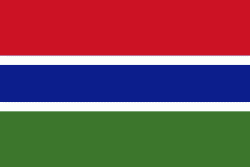Diabugu
Diabugu is a village in eastern Gambia. It is located in Sandu District in the Upper River Division. It is the biggest village in Sandu. It was founded by Foday Sillah about 1650. Foday Sillah's grandson Foday Sillah junior established the village of Jagejari as a farming centre. As time goes on some of his children settled there permanently.
Foday Sillah Junior's son Ba Sillah was the last Alkalo village head of Diabugu among the Sillah Kunda dynasty. Ba Sillah went to established a new settlement called Diabugu Ba Sillah South of the River Gambia. He then left the village to his first cousin and brother-in-law Mahamadou Mankoro Drammeh Sama. The Drammeh Sama of Diabugu has since inherited the leadership of Diabugu Batapa. Under the leadership of Mankoro's eldest son Madala Drammeh Sama, the Drammeh Kanji and Drammeh Sama were united. Inheritance of the Alkaloship is now based on seniority.
The first Drammeh Kanji to become Alkalo of Diabugu was Batapa Drammeh. He was a brave giant of Drammeh Kunda and because of this bravery, Diabugu has his name..
According to local sources, the following served as Headsmen of Diabugu the list is not exhaustive and based on narrations; 1. Foday "Baba" Sillah- Founding Father 2. Kissima Sillah, he later left to established his own settlement, East-south of Basse called Sabu-Sireh 3. Abdou Sillah 4. Ba Sillah the Sillah left clan left the settlement to establish various villages e.g Jegajari, Diabugu Ba Sillah Diabugu Badara, Madina Samako, Madina Nfally and transferred the Alikaloship to Drammeh 5. Ebrima Drammeh 6. Kekero Jalia Drammeh 7. Batapa Drammeh 8. Madala Drammeh 9. Kibili Kaka Drammeh 10. Kibili Henda Drammeh 11. Sorrie Juma Drammeh 12. Ka- Hammeh Drammeh 13. Ka Tamba Drammeh 14. Madala Tuguneh Drammeh 15. Alhagie Yugu kasseh Drammeh 16. Alhagie Kissima Sorie Drammeh 17. Mansa Drammeh 18. Alhajie Kursa Drammeh- The present Alikalo (Degumeh)
Diabugu is the most prominent Sarahuleh village, that embrace western education and it has lot of government facilities. Accordingly an infant school was established in the early 1940s, follow by a clinic and veterinary station. later in 1961, Gambia Government build a primary school to cater for the growing need of western education.
'''Diabugu also held chieftain of Sandu District. The Following served as Chiefs''': Batapa Drammeh (1925-1941) Yogou Kaseh Drammeh (1941/2-1972) Alhajie Seikou Baye Drammeh (1973- 1990) Ansumana Mansa Drammeh (2000-2003)
In 2016, it had an estimated population of 9,000.
Foday Sillah Junior's son Ba Sillah was the last Alkalo village head of Diabugu among the Sillah Kunda dynasty. Ba Sillah went to established a new settlement called Diabugu Ba Sillah South of the River Gambia. He then left the village to his first cousin and brother-in-law Mahamadou Mankoro Drammeh Sama. The Drammeh Sama of Diabugu has since inherited the leadership of Diabugu Batapa. Under the leadership of Mankoro's eldest son Madala Drammeh Sama, the Drammeh Kanji and Drammeh Sama were united. Inheritance of the Alkaloship is now based on seniority.
The first Drammeh Kanji to become Alkalo of Diabugu was Batapa Drammeh. He was a brave giant of Drammeh Kunda and because of this bravery, Diabugu has his name..
According to local sources, the following served as Headsmen of Diabugu the list is not exhaustive and based on narrations; 1. Foday "Baba" Sillah- Founding Father 2. Kissima Sillah, he later left to established his own settlement, East-south of Basse called Sabu-Sireh 3. Abdou Sillah 4. Ba Sillah the Sillah left clan left the settlement to establish various villages e.g Jegajari, Diabugu Ba Sillah Diabugu Badara, Madina Samako, Madina Nfally and transferred the Alikaloship to Drammeh 5. Ebrima Drammeh 6. Kekero Jalia Drammeh 7. Batapa Drammeh 8. Madala Drammeh 9. Kibili Kaka Drammeh 10. Kibili Henda Drammeh 11. Sorrie Juma Drammeh 12. Ka- Hammeh Drammeh 13. Ka Tamba Drammeh 14. Madala Tuguneh Drammeh 15. Alhagie Yugu kasseh Drammeh 16. Alhagie Kissima Sorie Drammeh 17. Mansa Drammeh 18. Alhajie Kursa Drammeh- The present Alikalo (Degumeh)
Diabugu is the most prominent Sarahuleh village, that embrace western education and it has lot of government facilities. Accordingly an infant school was established in the early 1940s, follow by a clinic and veterinary station. later in 1961, Gambia Government build a primary school to cater for the growing need of western education.
'''Diabugu also held chieftain of Sandu District. The Following served as Chiefs''': Batapa Drammeh (1925-1941) Yogou Kaseh Drammeh (1941/2-1972) Alhajie Seikou Baye Drammeh (1973- 1990) Ansumana Mansa Drammeh (2000-2003)
In 2016, it had an estimated population of 9,000.
Map - Diabugu
Map
Country - The_Gambia
 |
 |
The Portuguese in 1455 entered the Gambian region, the first Europeans to do so, but never established important trade there. In 1765, the Gambia was made a part of the British Empire by establishment of the Gambia. In 1965, the Gambia gained independence under the leadership of Dawda Jawara, who ruled until Yahya Jammeh seized power in a bloodless 1994 coup. Adama Barrow became the Gambia's third president in January 2017, after defeating Jammeh in the December 2016 elections. Jammeh initially accepted the results, before refusing to leave office, triggering a constitutional crisis and military intervention by the Economic Community of West African States that resulted in his removal two days after his term was initially scheduled to end.
Currency / Language
| ISO | Currency | Symbol | Significant figures |
|---|---|---|---|
| GMD | Gambian dalasi | D | 2 |
| ISO | Language |
|---|---|
| EN | English language |
| WO | Wolof language |















